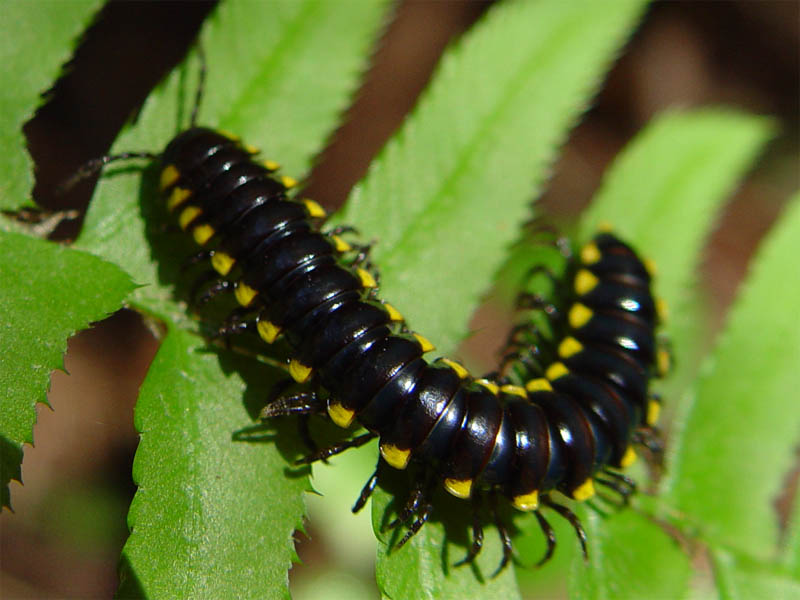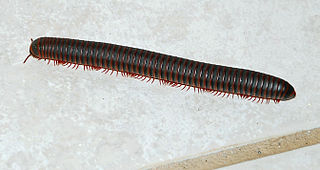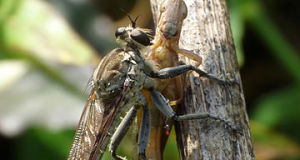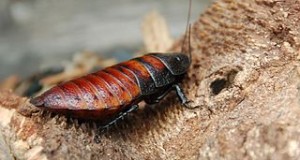Millipedes (Order Diplopoda) are among the most diverse yet least studied of all invertebrates. There are enough millipedes to keep generations of fans happy – over 12,000 species have been described so far, and we know little about most! Many species make hardy pets that adjust well to small enclosures and may even breed. All are quite intriguing – while working with arboreal South American millipedes at the Bronx Zoo, I was even involved in a mysterious “millipede emergency”…please see this article for details.
The following information can be applied to the commonly-kept African Giant Millipede (Achispirospreptus gigas) and many of the others that appear in the trade from time to time. Several millipedes native to the USA, such as Narceus americanus, are also large and brightly-colored…all are ignored by zoos and deserve more attention from hobbyists. Husbandry details will vary…please comment below for information on individual species.
Natural History
Millipedes are found on all continents except Antarctica, and live in varied habitats, including deserts, grasslands, caves, rainforests and human dwellings.
Most of the species studied consume and recycle dead leaves and other vegetation, and many defend themselves by curling into a circle and releasing irritating secretions. Certain monkeys rub their bodies with millipedes, apparently using these secretions to deter biting insects and parasites (please see below).
Despite common names suggesting the presence of thousands of legs, most species have less than 150 pairs. The “leggiest”, a rare millipede from the American Southwest, sports 750 legs (please see photo).
The popular Giant African Millipede, Achispirospreptus gigas, may reach 11 inches in length and 10 years of age.
Behavior
Millipedes are largely nocturnal in the wild but will remain active by day in humid terrariums.
Housing
Setting up the Terrarium
Millipedes are best kept in screen-covered aquariums or plastic terrariums. A 10 gallon aquarium is adequate for a single large adult.
“Ant farm type” type set-ups may allow you to watch your pets’ below-ground activities. A small aquarium placed upside down within a larger one will confine their burrowing activities to the area along the glass (please see this article on creating a burrowing area for details).
Substrate
Millipede substrate should be 4-6 inches deep and comprised of 50% leaf litter (oak, ash, etc.) and decaying wood. Millipedes will eat this, so you’ll need to add more in time. The balance may consist of coconut husk, peat moss and top soil. Although most will burrow, cork bark and similar shelters should also be provided.
Light
A reptile night-viewing bulb will allow you to observe your millipedes after dark.
Heat
 Most species do well at temperatures of 72-85 F (please write in for individual species’ details).
Most species do well at temperatures of 72-85 F (please write in for individual species’ details).
Red/black reptile night bulbs, ceramic heaters and under-tank heaters can be used to warm the terrarium. All have a drying effect, so be sure to monitor humidity.
Humidity
Millipedes are somewhat resilient to desiccation, but most favor high humidity and will become inactive if kept in dry terrariums.
Humidity can be increased by misting, moistening the substrate, and partially covering the lid with plastic.
Feeding
Deficiencies in calcium and other nutrients often prevent captive Millipedes from thriving. Leaf litter and decaying wood will provide nutrients that are hard to obtain otherwise. ReptoCal or a similar supplement should be mixed into the substrate (this will be consumed along with decaying leaves) and added to their food; a reptile vitamin supplement can be used once weekly.
Millipedes should also be provided with a salad of yam, carrot, kale, cucumber, apple, banana and other fruits and vegetables, into which has been mixed cricket gut-loading diet, tropical fish flakes, and tortoise pellets.
Companions
Millipedes get along well in groups, and may also be kept with beetles, stick insects, land snails and certain other invertebrates.
Molting
Millipedes usually remain below ground when molting, and should not be disturbed at this time. Humidity should be kept high when your pets molt.
Mites
Tiny white mites are often introduced to terrariums via substrate or food. Most are harmless scavengers, but large populations may disturb molting or injured animals. They can often be lured into a jar baited with fish flakes. Please see this article for further information.
Health Considerations
Millipedes release secretions that can irritate the eyes, skin and mucus membranes. Although pet trade species have not been shown to be dangerous, they should be kept away from the face and handled with latex gloves.
Always wash your hands with warm, soapy water after working around any animal. Please speak with your doctor concerning details, and feel free to write me for further information.
Further Information
Millipede Emergency: The Dark Side of a Peaceful Pet
Volunteer Opportunities Documenting Millipede Diversity
Millipede Toxins and Medical Concerns
Newly Discovered Millipede described as “Walking Sausage”
Harpaphe haydeniana image referenced from wikipedia and originally posted by Franco Folini
 That Reptile Blog – Reptile, Amphibian and Exotic Pet Care and Information
That Reptile Blog – Reptile, Amphibian and Exotic Pet Care and Information




